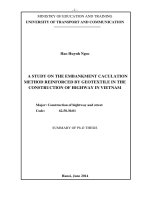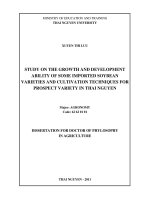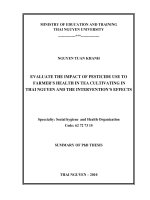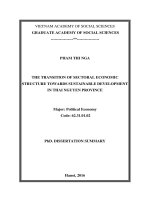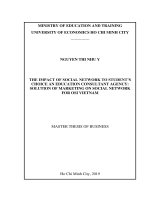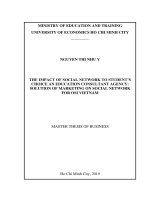Ph d dissertation abstract agriculture evaluate the impact of pesticide use to farmer’s health in tea cultivating in thai nguyen and the intervention’s effects
Bạn đang xem bản rút gọn của tài liệu. Xem và tải ngay bản đầy đủ của tài liệu tại đây (470.91 KB, 24 trang )
MINISTRY OF EDUCATION AND TRAINING
THAI NGUYEN UNIVERSITY
--------------***---------------
NGUYEN TUAN KHANH
Evaluate the impact of pesticide use to
farmer’s health in tea cultivating in
ThaI Nguyen and the intervention’s effects
Speccialty: Social hygiene and Health Organization
Code: 62 72 73 15
SUMMARY OF PhD THESIS
THAI NGUYEN – 2010
The research was conducted at:
THAI NGUYEN UNIVERSITY OF MEDICINE AND PHARMACY
Advisors:
1. Prof. PhD. Do Van Ham
2. Prof. PhD. Nguyen Van Dip
Opponent 1: …………………………………………
Opponent 2: …………………………………………
Opponent 3: ………………………………………….
The dissertation will protected in front of State Dissertation
Appraisal Council at: Thai Nguyen University of Medical and
Pharmacy
At…..hours on….. date…………………..month……..year….
The information from this dissertation is available at:
- National Library.
- Learning Resource Center, Thai Nguyen University.
- Library of Thai Nguyen University of Medical and Pharmacy.
1
INTRODUCTION
Using pesticides is a objective reality and a indispensable action
in agricultural production. World due to the effects of pesticides (P) is
estimated about 39 million people yearly acute poisoning and 3 million
people among them with heavy acute poisoning and 220 thousand
people yearly dead people all over the world.
Current situation of poisoning pesticides in Vietnam are still
becomes serious. According to Ha Minh Trung, Vietnam is estimated
that if there are about 11.5 million agricultural households with rate of
18.26 % poisoned chronic by pesticides, the number of chronic
poisoning in the country up to 2.1 million. The main reason is due to
abusing and use and indiscriminate pesticides, particularly 98.0 % due
to abuse or mix 2 to 3 times condenser than guide on the package,
with 84.17 % to 93.23 % not adequate using personal protective
equipment (PPE) when spraying.
The most pesticides using is in cultivating tea about both
quantity and frequency of injection. Thai Nguyen has an area of
nearly 16,000 hectares of tea, tea cultivation in many areas of remote
and disadvantaged areas, socio-economic conditions of
underdeveloped, low education level. Knowledge, practice about
using pesticides is still restrictive, which causes bad effect on human
health. To contribute for taking care of farmer health cultivating tea
and build suitable interfere model with actual condition at these areas,
we carry out researching this thesis with a view to:
1. Describe the knowledge, attitude and practice (KAP) of
farmer exposure to pesticides.
2. Determine disease model and describe some factors related to
farmer health in cultivating tea
3. Construction and appreciate of effect of interfere model on
human health protection suitably for current conditions in Thai
Nguyen.
2
Charter 1
DOCUMENT OVERVIEW
Pesticides is used spreadingly at every nation in the world with
income over USD 30 billion from 2005.
1.1. The situation of using pesticides and knowledge, attitude and
practice of farmers usually contact with pesticides
1.1.1.The situation of using pesticides
Pesticides had existed from ancient period and until19th century,
it was used widely but chemical methods at this time have not had big
role in agricultural production. From the beginning of 20th century to
1960, oganic pesticides was invented and chemicals is used at
maximum level and its bad consequences had started causing human
and environment. The period from 1960 to 1980 had left many bad
consequences on environment and community health. From 1980s to
now, environment protection is paid more attention. In Vietnam,
pesticides is used from 1957, means the periods of centered – plan
economy from 1957 to 1990: importing and distributing pesticides
depends on the state. Amount of pesticides was not used much, only
about 15,000 tons per year. Most of them were medicals with so long
reserved time or high poison. Period from 1990 to now, market
economy with available goods and many types is used in timely.
Amount of pesticides is used for heavy industry increasingly.
1.1.2. Knowledge, attitude, practice of person contacting with
pesticides.
Researches show using situation, unsafe pesticides reservation,
lack of knowledge in obeying labor protection methods. Most farmers
is lack of awareness, knowledge, subjective attitude about poison and
practice untruthfully.
1.2. Effect of pesticides and some of risk factors related to
farmer’s health
Risk of environment polution: Result for study pesticides at
some locals shows that amount pesticides in land, water and food at
dangerous level and increasing risk.
3
Effect of pesticides on human health includes pernicious and
chronic poison
1.3. Some studied intervention models to protect human health when
exposure to pesticides has been deployed out in Vietnam
The thesis related to this problem is still rare, especially in
mountainous areas, highland such as Thai Nguyen. Some interfere
researches have been carried out at some area in Vietnam: The thesis
11-08 of Ministry of Agriculture and Rural Development in
combination with Ministry of Health and Ministry of Defence has
implemented from 1996 to 2000. In 2002, Bui Thanh Tam and her
parner researched community model for using pesticides safety at a
district of low land and a district of Northern highland. The subject
Job Department of Occupational Health - University Thai Nguyen of
Medical and Pharmacy has carried out many thesises related to human
health in agriculture labor but it is only at experimental level. Until
now, no thesis helps to protect farmer health cultivating tea when
contacting with pesticides. Therefore, carrying out a research to take
care of farmers here is very nescessary.
Charter 2
SUBJECTS AND METHOD
2.1. Subjects
2.1.1. Subjects described
- KAP study subjects, examinations assess the actual structure of
common diseases and interventions are in direct spray pesticides in
the tea growing households, have time for 5 years and tea area about
over 1800 m2.
- Person investigated and interviewing detail is bosses of
pesticides selling shops at Tan Linh commune, People Commitee
leader, Chairman of commune farmer Union, Chairman of the
Commune Women's Union and some farmers.
- Audience research is the only toxic products.
4
2.2. Place of the research
Be carried out at Phuc Xuan commune - Thai Nguyen city and
two communes including Phuc Linh & Tan Linh, Dai Tu district, Thai
Nguyen province. This research is intervention at Tan Linh and
controls Phuc Linh commune.
2.3. Time of the research: From January 2007 to June 2010.
2.4. Research method: Epidemiology research design describes
cross-sectional design in combination qualitative and quantitative.
Participation of community.
2.5. Sample size and sampling method
2.2.1. Sample size for descriptive study
Describing sample interviews farmer’s knowledge, attitude,
practice (KAP).
Applying formula calculating sample size basing rate:
n = z2(1- α/2) p(1-p)/d2.
With given number, n = 385 people. Person appreciated is 877
farmers usually contacting with pesticides in 385 households.
2.5.2. Sampling intervention studies
- The sample size for intervention studies as follows:
n = (Z 1- α/2 + Z 1 -β)2 p1 q1 + p2 q2
(p1 - p2 )2
With given number, n = 90.16 (about 91 people). Take extra 20 %
like this, sample size for each commune is 119 people.
2.6. Research design technique
2.6.1. Describing study
Epidemiology research design describes cross sectional design in
combination qualitative and quantitative
2.6.2. Intervention study
Community intervention with comparison.
5
Intervention activities
Communications: Combine direct communication with indirect
communication with an aim to change behavior. Direct
communication: Through training time, conference, practice guide.
Especially, through club activity "Farmers - Small business- Medical
staff". Indirect communication: On Media include many kinds and
means.
Examination of patients, drug treatment for some common
diseases. Advise about health for pesticides user.
Chapter 3
RESULTS
Research 385 persons, we have the following results:
3.1. The current status of KAP about pesticides of tea cultivating
farmer in Thai Nguyen (n = 385)
Table 3.2. Pesticides using time basing on sex
Sex
5-10 years
> 10 years
n*
%
n
Male
47
12.2
134
34.8
181
47.0
Female
63
16.4
141
36.6
204
53.0 >0.05
Total
110
28.6
275
71.4
385
100
%
Total
n
P
%
* n = Quantity
Table 3.2 shows:
Pesticides using time of above person over 10 years 71.4 %. Female
(53.0 %) is more than male (47.0 %), p > 0.05.
6
Table 3.4 Knowledge of weather and wind direction chosen when
spraying pesticides
No.
Content
Know
Unknown
n
%
n
%
1
Cool weather
351
91.2
34
8.8
2
Walking backwards
311
80.8
74
19.2
3
Downwind
171
44.4
214
55.6
4
Know fully
114
29.6
271
70.4
Table 3.4 shows: Know spray downwind low rate of 44.4 %, the rate
is very low that a full 29.6 %
Table 3.8. Know about health conditions to ensure the spray
No. Health conditions to ensure
the spray
Know
Unknown
n
%
n
%
1
Don’t spray when there are
sick, pregnant, lactating
333
86.5
52
13.5
2
Older, children who do not
go spraying
312
81.0
73
19.0
3
Periodic health examination
139
36.1
246
63.9
4
Not spraying over 2 hours/
day, two weeks/phase
98
25.5
287
74.5
5
Know fully
81
21.0
304
79.0
Table 3.8 shows that rate of farmers with full knowledge is very low (21.0
%). Rate of the elderly and children still use to pesticides (19.0 %)
7
Table 3.12. Pesticides mixed practice
No.
Pesticides mixed
practice
Yes
No
n
%
n
%
1
Solider
50
13.0
335
87.0
2
Estimate
8
2.1
377
97.9
3
Mixture a kind
68
17.7
317
82.3
4
Mixture > two kinds
317
82.3
68
17.7
5
Exact mixture
67
17.4
318
82.6
Table 3.12 shows that mixture rate of many kinds of pesticides when
spraying is very high (82.3 %), rate of farmers exact practice mixed
pesticides the guide is very low (17.4 %).
Table 3.13. Practice using personal protective equipment
Use personal
protective
equipment
No.
Yes
Quantity
No
%
Quantity
%
1
Mask
355
92.2
30
7.8
2
Glove
208
54.0
177
46.0
3
Protective clothes
263
68.3
122
31.7
4
Hat
246
63.9
139
36.1
5
Glasses
46
11.9
339
88.1
6
Full use
25
6.5
360
93.5
Table 3.13 shows that: rate of farmers spraying and using mask is
very high (92.2 %).
The lowest rate is glasses use (11.9 %), rate for use all kinds of
personal protective equipment is very low (6.5 %)
8
Was guided
Not guided
Not guided,
16.6%
was guided;
83,4%
Chart 3.4.Rate buyer's guide seller use pesticide and poisoning
prevention
Table 3.16 Information supply resource
No.
Information Supply
Resource
Yes
Quantity
No
%
Quantity
%
1
Medical staff
263
68.3
122
31.7
2
Plant Protection
Officer
37
9.6
348
90.4
3
Pesticide seller
226
58.7
159
41.3
4
Radio
158
41.0
227
59.0
5
Newspaper
94
24.4
291
75.6
6
Televisions
223
57.9
162
42.1
Table 3.16 shows that high rate of Information supply resource is
Medical staff (68.3 %), pesticides seller (58.7 %)
9
3.2. Health situation and some factors related to the health of people
regularly exposed topesticides
- The most muscle symptoms of farmers contacting with
pesticides during the last time is nervous system, digest. Some
popular symptoms such as tiredness (77.9 %), headache (73.1 %),
dazzle, vertigo (78.4 %. Some disease groups with high rate such as
diseases about nose and sore (86.9 %), eyes (84.8 %), bone muscle
(63.7 %), skin (40.1 %), etc.
- The risk is due to: unsafe pesticides mixture, solider pesticides
mixture than guide, mix many kinds of pesticides in the spray related
to disease nose and throat, increased 2.66 times compared with the
correct mixture.
- The risk to spraying the windward with nose and sore diseases
is 2.55 times more than right the wind direction pesticides
- The risk of going on with disease due to unsafe medicine
mixture is 2.31 times more than right mixture. The risk of having eye
disease due to spraying wind ward increases 3.27 times more than
using glasses.
3.3. Results of intervention studies
3.3.1. Intervention activities
- Build Project implement leading committee, propose
commune People Committee to set up "Farmers - Small business Medical staff" club basing on links between “Farmer – The sale of
pesticide – commune Medical staff”, keep the club once three
months.
- Organize three training classes for main officers to take charge
of the program, organize 14 training days at village (a day for each
village) with 856 participants.
- Celebrate 02 conference days at commune People Committee
with 397 participants. 04 training days at the edge.
- Deliver 1000 books: “Chemicals are used for agriculture and
community health”. Deliver handout to all 1469 households.
Propagandizing on media of commune (259 days).
10
- All 6 commune Medical staff are trained again about against
pesticides poison. Project Steering Committee combining with
Commune People's Committee managing pesticide suppliers, vendors.
- Every month, Management committee meets "Farmers - Small
business - Medical staff" to appreciate results and withdraw
experiments for activities in month and build next solution.
Table 3.21. Synthetic training, communication activity
No.
Activity content
Subjects
Committee Steering Committee
Times
People
24
381
1
Steering
meeting
2
Communication skills Collaborator,
training
pesticides seller,
commune Medical
staff
3
96
3
Train for commune Commune officer
Medical staff
3
17
4
Workshop (session)
Commune People
committee and study
subjects
2
297
5
Training at village
Farmers
14
856
6
Practice in the field
Study subjects
4
472
7
Club activities
Club members
8
208
Activity to protect health when exposure with pesticides
- Organize periodical medical examination, advisory and care for
human health on using pesticides, discover health problems at farmers
exposed to pesticides. Keep clinic to discover health problems at Tan
Linh commune health station. Test quantitative blood samples enzyme
cholinesterase.
11
- Supply medicine to treat free for patient; advisory and
introduction to go to treat heavy diseases.
- Celebrate summary conference to appreciate effectively model
"Farmers - Small business - Medical staff".
3.3.2. Effect of interfere solutions at Tan Linh
Table 3.22. Knowledge of Medical staff and pesticide sellers
Target
Preintervention
n
%
Postintervention
n
%
1. Medical staff (n = 6)
Be trained
0
0.0
6
100.0
3
50.0
6
100.0
Know poisoning prevention advice
4
66.7
6
100.0
Know to guide how to use, reserve
2
33.3
6
100.0
Be trained
0
0.0
4
100.0
Know poisoning prevention advice
1
25.0
4
100.0
Know to guide how to use, reserve
3
75.0
4
100.0
Having business registration
2
50.0
4
100.0
Know
to
poisoning
treatment
pesticide
2. Pesticide sellers (n=4)
Table 3.22 shows that:
- Before the intervention, no Medical staff and pesticides seller is trained.
- After the intervention, 100 % pesticides seller and Medical staff know
how to use, storage as well as prevention of pesticide poisoning.
- The number of stores selling pesticides already registering business
increases by from 50 % to 100 %.
12
Table 3.32. The result oftesting is comparition about active
Enzym Cholinesterase (Normally 5,300-12,900U/L).
Tan Linh
Phuc Linh
Test 2nd
Index
Test 1st
Pre-intervention Post- intervention
n=60(1)
n=51(2)
n=60 (1)
n=51(2)
n
%
n
%
n
%
n
%
<5300U/L
5
8.33
1
1.96
4
6.66 6 11.76
X ± SD
6744+ 1175
8800+2206
7324+1966 8354+2995
P1.2
< 0.001
>0.05
Result of Table 3.32 shows that:
- At Tan Linh after 2 years intervention activity enzyme
cholinesterase average has increased. The ratio of person who has
actived enzym below normal standard decreased from 8.33 % to 1.96
%.
- At Phuc Linh the ratio of person who has active enzym below the
normal standard will have tendency increasing (from 6.66 % to 11.76
%).
Table 3.33. Comparing result test of pesticides in tea before and
after intervention about all kind pesticides/01 sample and some
kinds of pesticides average/01 sample
Tan Linh
Phuc Linh
Kind of
PrePostpesticides /01 intervention intervention
sample
n= 15
n=15
First
test
n=15
Second
test
n=15
Most
15
13
13
15
At least
5
4
2
2
6.46
5.80
6.00
6.86
P
Average
pesticides/01
sample
>0.05
<0.05
13
Result of Table 3.32 shows that: Total all kind of chemical noxious is
average to discovery on 01 sample at Tan Linh has decreased from
6,46 kinds /sample to 5,80 kinds /sample
Meanwhile at PhucLinh increase from 0,6 kind/ 01 sample to 6,68
kinds/sample. The difference is statistically significant p <0.05.
Table 3:37. Really effective for KAP's growing up tea exposure to
pesticides after 2 years of intervention at Tan Linh
Group
The specific targets
Index. Interve
Index.
Effective Effective -ntion
Interven Control effect
-tion %
%
%
Knowing the treatment of poisoning
88.7
22.1
66.6
Knowing full kind of PPE
74.8
19.2
55.6
Know the health conditions when
64.9
9.5
55.4
spraying
Know Understanding the colour on the pack 67.1
13.5
53.6
-ledge Understanding how to mix pesticide
56.0
3.7
52.3
Know how maintenance and storage
64.5
16.7
47.8
Understand how to spray
72.0
25.1
46.9
Understand the purpose of (P) use
52.3
17.0
35.3
Know the way into the body
43.6
15.4
28.2
Know the harmful effects of (P)
36.9
14.5
22.4
Know the symptom of poisoning
44.1
22.6
21.5
Interesting to wind direction
10.9
3.5
7.4
Attitu Needed to use PPE
3.4
0.8
2.6
-de
Worried poisoning when exposed (P)
2.6
2.5
0.1
Mix pesticide correctly
72.1
10.6
61.5
Practi Spraying pesticides correctly
46.7
2.6
44.1
-ce
Using full of PPE
88.0
60.5
27.5
Don’t allow to use pesticide forbid
23.1
10.1
13.0
Result of table 3.37 shows that: After 2 years intervention,
model of education to prevent from noxious of pesticides to give clear
result, knowledge and practicing has raised, knowledge of
intervention effect to achieve 66,6 % and practicing has raised to 61,5
% achieve too.
14
Table 3.38. Really effective for health of person who growing up tea
contacts with pesticides after 2 years intervene at Tan Linh.
Group
The specific targets
Index Effective
Index Effective
Intervention %
Control %
Intervention
effect %
Increased salivation
63.4
8.4
55.0
Nausea
55.3
4.4
50.9
Muscle weakness
FunctiEasy to stimulus
onal
sympt- Dry throat
oms
Itchy Skin
53.3
8.4
44.9
43.5
2.6
40.9
40.7
0.0
40.7
34.9
5.6
38.3
Watery eyes
39.7
1.8
37.9
Blurred vision
39.0
2.8
36.2
Shake hands, feet
38.2
3.3
34.9
Vertigo, dizziness
34.9
0.1
34.8
Cough
35.0
1.5
33.5
Insomnia
32.9
1.2
31.7
Supine
31.8
1.0
30.8
Headache
36.0
8.4
27.6
Fatigue
29.5
3.5
26.0
Urology
60.3
5.1
55.2
Respiratory
61.4
9.3
52.1
Eyes
52.3
8.8
43.5
39.9
4.0
35.9
42.6
7.8
34.8
45.5
12.1
33.4
Cardiology
35.8
13.8
22.0
Neuropsychiatric
30.6
14.9
15.7
Digestive
21.8
7.0
14.8
Diseas- Musculoskeletal
ed
Nasopharyngeal
entity
Dermatology
Comments:
15
Result of table 3.38 shows that after 2 years intervene the ratio of
disease has decreased, health of person who using of pesticide has
improved. Intervention effect is the highest 55 % (increased
salivation), the lowest has achieved 14,8 % (digestion)
Chapter 4
DISCUSSIONS
4.1. Knowledge, attitude, practice (KAP), use, preservation and
prevention of pesticide poisoning of tea cultivation
4.1.1. Some characteristics of study object
By studying 385 subjects, we realize that secondary education
accounted for 76.6 %, 13.5 % high school, elementary only 9.9 %.
There is no illiteracy. Therefore, training, coaching, counseling of
knowledge of pesticide poisoning prevention becomes easier to
acquire. About sex, male makes up lower rate than female (female
accounts for 53 % and male 47 %). A concern is that the percentage
age of female having time to use pesticide more than 10 years
accounts for higher proportion than male. In the study results, we can
find that some one at the age of 20 years have exposure to pesticides
for 5 years. That means that they sprayed pesticides at the age of 15
years. Interviewing Mr Tran Dinh D…, Health Station Chief says:
“Some old people often have to spray Pesticides because their
children work far away. At hamlet 7, Mr Hoang Quoc A.. at the age of
79 years and Mrs Le Thi H…at the age of 74 years still must spray
pesticides”. This is the matter about which public health must care
more in examining periodic health and health protection for people
here.
4.1.2 KAP use, preservation and prevention of pesticide
poisoning
Knowledge, practice about using, preservation of pesticides is
low. Most of KAP index does not reach 50 %. The majority of tea
cultivator have active attitude to using pesticides (account for over 90
%), this is an important reason which can help intervention model be
16
successful. The public’s good attitude to preventing pesticide
poisoning can help the model be feasible and the model is preserved
sustainable in the community.
Supply source of information to the public about how to use,
maintain, and prevent toxic account for high proportion: (68,30 %)
from medical staff, 58,7 % from seller of pesticides. This is the point
which the research group chooses as breakthrough point, impacting on
correct subject in the direct communication activities. 83,4 % age of
buyer is guided how to use by the seller. However, they just receive
poor information such as the way to choose the suitable one for each
kind of tree, kind of pestilent insect. The store owner’s knowledge is
limited; moreover, the source of information which they supply to
customer is poor. Normally, they just introduce what kind of
pesticides is suitable with the pestilent insect correlatively. They don’t
grasp the knowledge of using pesticides especially poor knowledge of
how to prevent toxic of pesticides. There is a lack of communication
documents. Ms Nguyen Thi Th….at the age of 39 in hamlet 6, Tan
Linh, the shop owner of pesticides shows that: “Most of people who
come here to buy pesticides are always guided how to use, however,
normally buyers just ask that their tea plant infected this kind of
pestilent insect or other one, so what kind of pestilent insect they have
to buy. Few people ask how to prevent poisoning. If they ask, we don’t
understand to explain to them”.
4.2 Health situation of people who cultivate tea
Some expressions such as being dizziness, vertigo accounts for
78.4 %, fatigue rate is 77.9 %, and headache rate is 73.1 % (table
3.17).
The remarkable thing is the expressions of disease entities in
some organs. Eye disease (84.8 %), nasopharyngitis (86.9 %),
musculoskeletal joints (63.7 %), neuropsychiatric (51.1 %) (table
3.18).
4.3. Problem identification and intervention modeling to prevent
pesticide poisoning and the effectiveness of interventions
17
4.3.1. Identify intervention problems and build the model
From above analysis result, we choose the solution and build
intervention model. The name of model: "Prevention of pesticide
poisoning", some technical measure in intervening: This study used
both direct and indirect communication which changed action,
combined with periodic medical examination to detect, and to treat
some diseases relating to pesticides. Some of the newest tendency and
method: Linking between the users of pesticides (Farmer), traders of
pesticides (Small business), and health workers (Medical staff). We
call as "Farmers - Small business - Medical staff”. In this topic, we
choose breakthrough point into the key stage is the main reason of the
matter for highly effective selective and important intervention.
- The Farmers exposed to pesticides are subject to interventions for
changing benefit action to health and is also object need examining,
management and taking care of health.
- The seller of pesticides need to intervene to interventions the
knowledge, counseling skills and is a direct communicator most
effectively to usage, storage of pesticides. In fact, 83.4 % of buyers
are guided how to use pesticides by sellers.
- Medical staff are subject necessary to intervene to improve
capacity of the treatment of poisoning and counseling skills. Also a
direct communication are most effective for the prevention of
pesticide poisoning.
4.3.2. The effect of intervention method
4.3.2.1. The effectiveness of intervention method changes KAP of
pesticides user.
After intervening 2 years, the public’s knowledge has been
improved remarkably. The Index Effective obtains from 36.9 % to
88.7 %. The actual effect is between 21.5 % and 66.6 % (table 3.37).
Most of farmers's knowledge has been improved above 20 % in
comparison with that before intervention.
18
Active attitude to supporting the use of workwear and poison
prevention reach 100 %. This is a convenient factor which can help
project be successful.
The rate of the public who practices in a true way, has been
improved significantly after intervening 2 years and efficiency
indicator achieves from 23.1 % to 88.0 %. Actual intervention
effectiveness is from 13.0 % to 61.5 %. Comparing the effectiveness
of intervention method at Tan Linh and Phuc Linh commune is
different significantly (p <0.05).
4.3.2.2. The effectiveness of intervention method of improving
people’s health who cultivate tea plant.
Overall the rate of functional symptoms were significantly, more
than 25.0 % comparing with that before intervention (p<0,05).
Headache decreased from 84.0 % to 53.8 % from 82.4 % fatigue
down 58.1 %, dizziness from 86.6 % to 56.4 %, trembling limbs from
70.6 % to 43.6 %, irritability from 52.9 % to 29.9 % (table 3.35). In
comparison index of effective intervention group (29.5 % to 63.4 %)
and control group (0 % to 8.4 %), we can see that index of effective of
intervention group is higher than that of control group. Actual
intervention efficiency is from 26.0% to 55.0% (Table 3:38)
Entity diseases of nose - throat decreases from 84.9 % to 48.7 %,
for eyes disease, there is a decrease from 95.0 % to 45.3 %. In our
opinions, correct practice rate of intervention group has been
improved. The use of mask and protection glass limits the penetration
of pesticides into body. Besides, the intervention group usually
examines and treats disease at once; therefore, the disease rate of
intervention group is lower than that of control group.
Through the result in table 3.38 we can see that the disease rate
decreases after intervention. Actual intervention efficiency achieves
14.8 % to 55.2 %. To sum up, the initial target of project meets and
exceeds the target.
4.4. Retention ability and model expansion
4.4.1. Feasibility and sustainability of the model
19
- Suitable model with Policy guidelines of Party and State towards
agriculture, farmer and rural, farmer’s health is interested in by whole
society. Local Communist Party and Government supported intervention
model. Commune government committed to maintaining and to
promoting the effect of model “"Farmers - Small business - Medical
staff” in which the core of activities is Commune Medical Staff, and
pesticide sellers especially the response of farmers.
- Intervention model linked the relationship among Farmer Small business and Medical Staff. Through training courses and
conference, trader of pesticides and local medical staff know the
communication skills of health education, and know how to use PPE
and means of preventing poison of pesticides. After being trained, the
farmer can grasp basic knowledge of preventing pesticide poisoning
and especially their trust in trader of pesticides and local medical
staff. They are willing to exchange their difficulties when using
pesticides to pesticides sellers and local medical staff.
- This intervention model “simply but effective” is easy to deploy in
a large scale, the resource don’t need to be fit too much with economic
condition in mountainous and highland area. The model has overcome
some limitations that some previous encounter model is required
enormous resources, the apparatus complex operations, while pouring
money into the best result, project completion no pouring money the
model is not sustainable, does not exist.
- Sustainability of model: Because operation of model brings
benefit for 3 factors which create the model: the farmer know how to
prevent pesticide poisoning, reduce the number of cases, reducing the
time hospital stay, hospital charges... especially health are guaranteed,
this is the most precious property. When they are healthy, they can
generate wealth for themselves and for society, get rich and contribute
to their poverty reduction in particular and community in general.
Traders of pesticides sell a great deal of pesticides because the people
believe in only buying pesticides to their stores. Local medical staff
finishes the plan of taking care of and protecting the public’s health,
contributing to the successful implementation of local society economic indicators, improving the living quality for rural people.
20
The result of model is a clear proof to convince local leaders and
farmers to use pesticides. The above basic factors help the model
succeed and keep up the model’s sustainability.
4.4.2. The new points of the dissertation
- The dissertation gave indicator of KAP and structural disease of
farmer growing tea in Thai Nguyen. Particularly the model building
intervention to protect the health of farmers growing tea first fit the
characteristics of mountain areas. That model is based on three factors
cohesion "Farmers - Small Business - Medical staff".
- The model “Farmer- Small Business - Medical Staff” is a new
discovery of innovative approaches. This is the first model to be
deployed in communities to improve the health of farmers growing
tea, the analysis highlights selected for intervention and key
interventions. Model found the dialectical relationship between
objective "Farmers - Small Business - Medical staff".
Farmers need Medical staff and pesticide sellers, and to reverse
the pesticide sellers and Medical staff need farmers. Organic
relationship and this has helped dialectical topics implemented
smoothly and successfully. Especially the later stages to maintain the
sustainability of the model.
CONCLUSION
1. KAP actual situation of the farmers growing tea
- The tea cultivator’s knowledge of pesticides: Full understanding of
the effects of pesticides rate was 37.9 %, full understanding of
harmful of pesticide makes up 50.1 %. Understanding how to choose
weather and wind direction when spraying was 29.6 %, full
understanding how to keep safely makes up 24.4 %. Understanding
how to read the warning of toxic level through color bars on drug
labels accounts for 14.5 %. Understanding the way of penetrating of
pesticides into body makes up 40.5 %. Understanding of the necessity
to ensure the health pesticides reached 21.0 % Know all the symptoms
of pesticide poisoning 22.6 %, and know the treatment of pesticide
poisoning by 5.5 %.
21
- The tea cultivator’s attitude to using pesticides: 97.4 % of them are
worried about their health when spaying pesticides, 98.7 % of user of
pesticides said that it is necessary to use personal protective
equipment..
- Practice of using pesticides: Mix up many kinds of pesticides into a
bottle when spray is 82.3 %. Full usage of personal protective
equipment accounts for 6.5 %. Buy and use pesticide banned from use
by 17.1 %. Handling containers after use: throw haphazard or reuse
21.9 %.
- Sources of information for people on how to use, preservation and
prevention of poisoning a high proportion is 68.3 % from health
workers, 58.7 % were from the pesticides sellers.
2. Effects of pesticides to farmers' health
- Rates of some functional symptoms: dizziness, vertigo is 78 %,
fatigue is 77.9 %, headache is 73.1 %... (table 3.17).
- The rate of some disease entities: Eye diseases is 84,8 %,
nasopharyngitis is 86.9 %, osteoarthritis is 63.7 %, neuropsychiatric is
51.1 %, dermatology is 40.1 %... (table 3.18).
3. The effectiveness of intervention model
- After intervening two years, the public’s knowledge has been
improved remarkably, the rate of efficiency indicator obtains from
36.9 % to 88.7 %. Efficiency actually achieved after intervention from
21.5 % to 66.6 %. The rate practice the correct have improved
remarkably, achieving efficiency index from 23.10 % to 88.0 %.
Effective actually reach from 13.0 % to 61.5 %.. (table 3.37).
- Some funtion symptoms as well as entity diseases in those who
exposed to pesticides decrease considerably after intervention,
especially symptoms of headache reduce from 84.0 % to 53.8 %,
fatigue decreases from 82.4 % to 58.1 %, dizziness decreases from
86.6 % to 56.4 %, limb trembling reduces from 70.6 % to 53.8 %.
Disease entity in nose - throat reduce from 84.9 % to 48.7 %, eyes
diseases decrease remarkably (95.0 % to 45.3 %). Actual intervention
effectiveness is from 14.8 % to 55.2 % (table 3.38).
22
- There is so much improvement in enzyme cholinesterase active
of intervention group, and the rate decreases below the average at 1.96
%, while control group still reduces below average at 11.76 %. There
is a significant difference between intervention group and control
group (p<0.001).
- The local medical staff’s capacities has been improved,
especially communication skills poisoning prevention, examination,
find out and treatment symptoms poisoning pesticides. Propagator
introduces trader of pesticides in model and guides the farmers to use,
preservation and prevention of poisoning pesticides. (table 3.32).
- Leaders of the Party Committee, People’s Committees of
Commune and farmers high appreciate and accept to maintain the
model after the project ends.
RECOMMENDATIONS
Based on these results we have a number of recommendations
follows:
1. Base on “Farmers - Small Business - Medical staff” model, local
party and government at Tan Linh commune - Dai Tu District - Thai
Nguyen Province invest the labor resources; keep up Intervention
Model of communication education of occupational safety in
maintaining and preventing poison of pesticides.
2. Expand the model to all district and other tea growing areas, trial
research of model in other tea growing areas such as: rice, vegetable
and crops.
3. Health sector need to develop program and organize to examine
and manage public health periodically. Enhancing to train for medical
staff in prevention and treatment of diseases related to Pesticides.
Early detection of pathological disorders related to insecticide treated
promptly.

